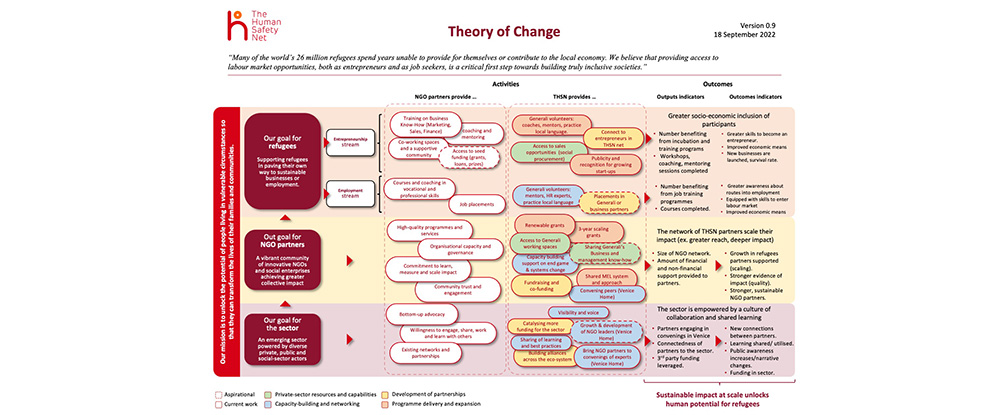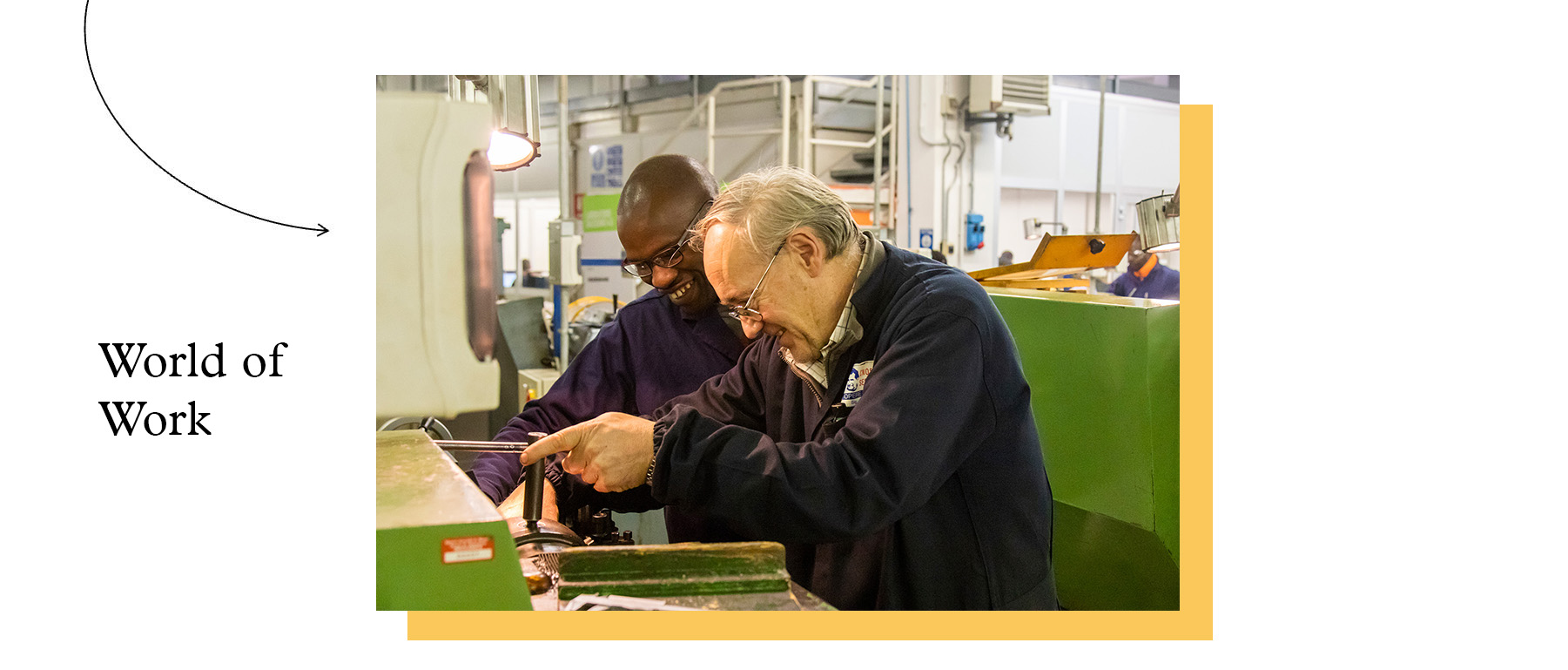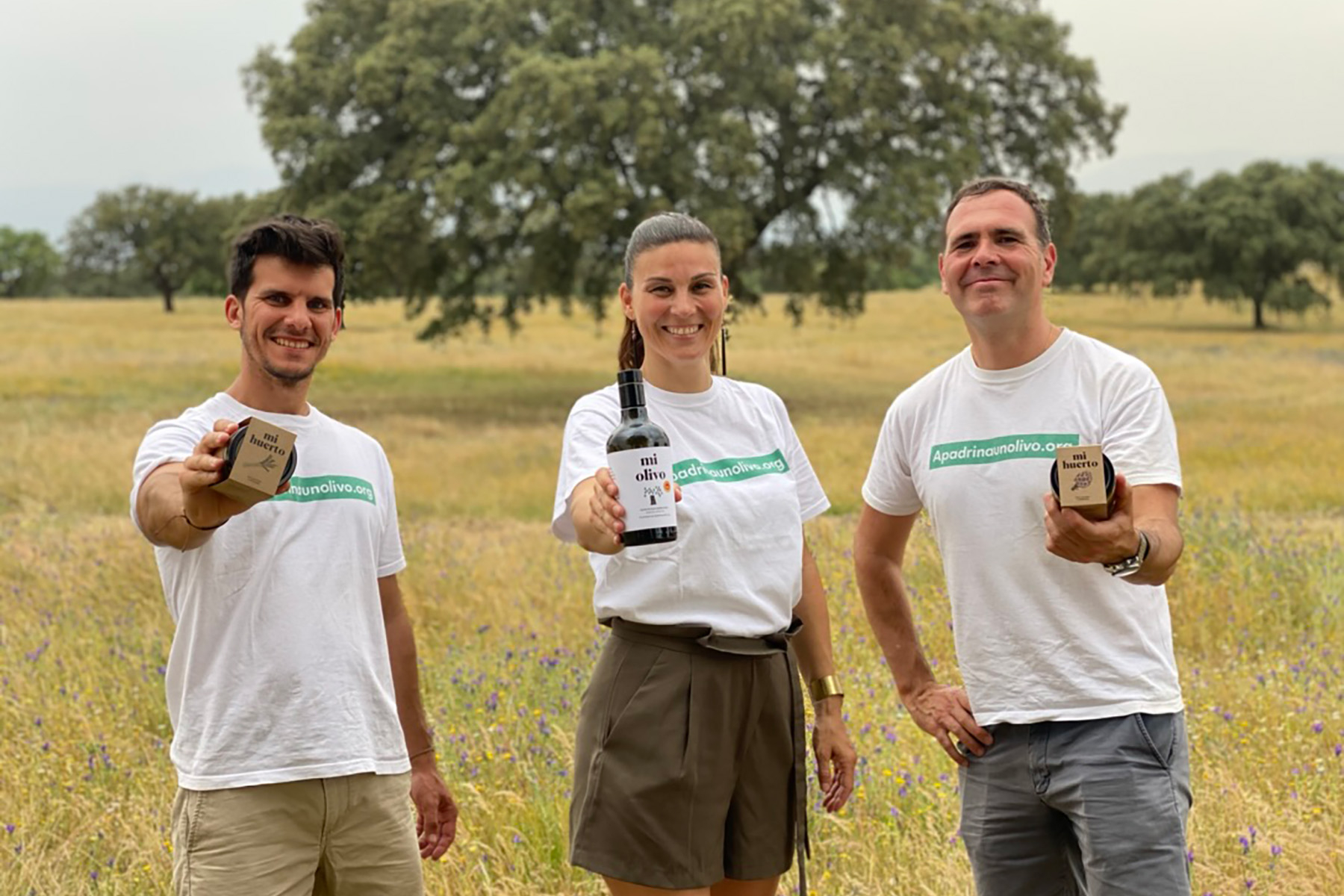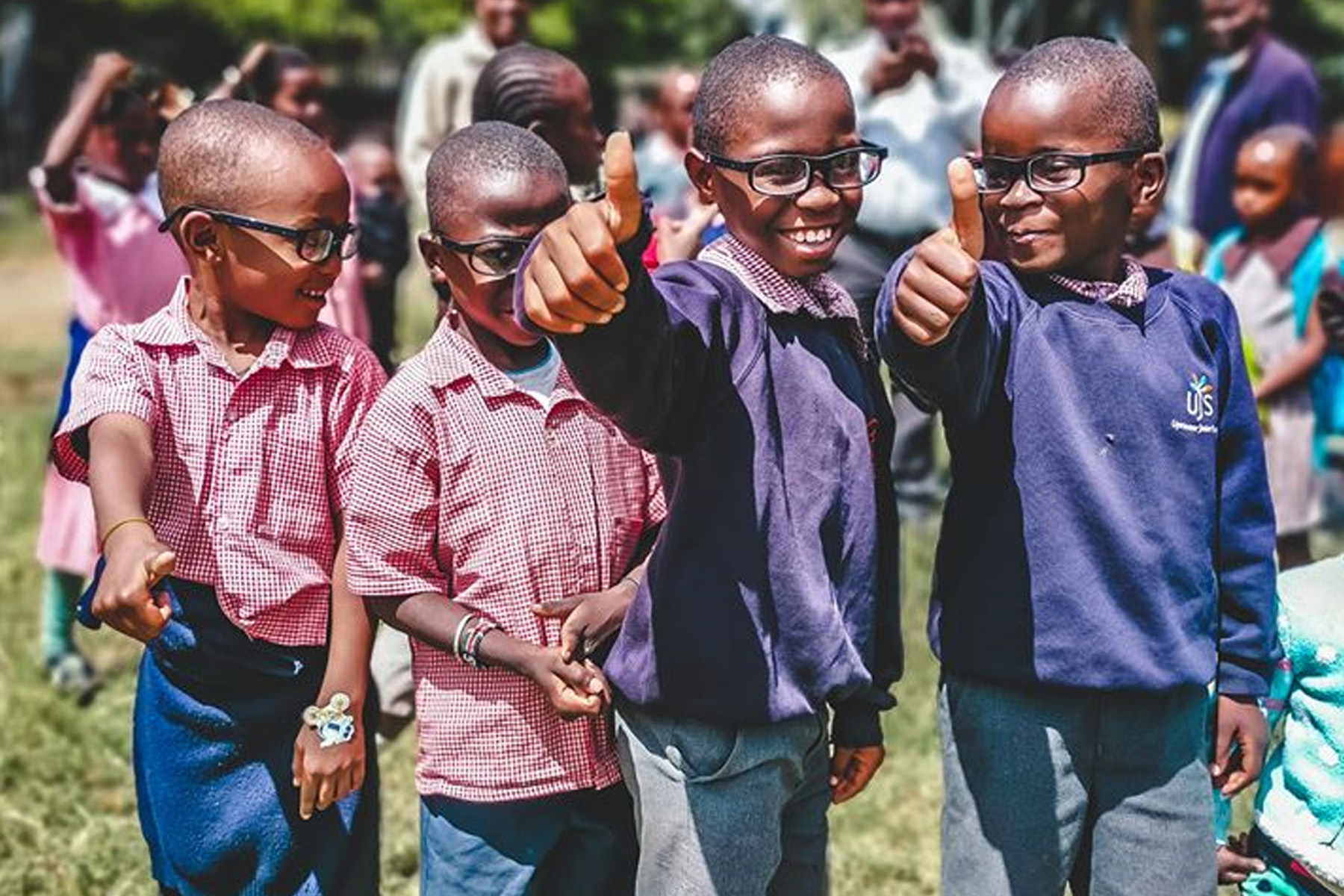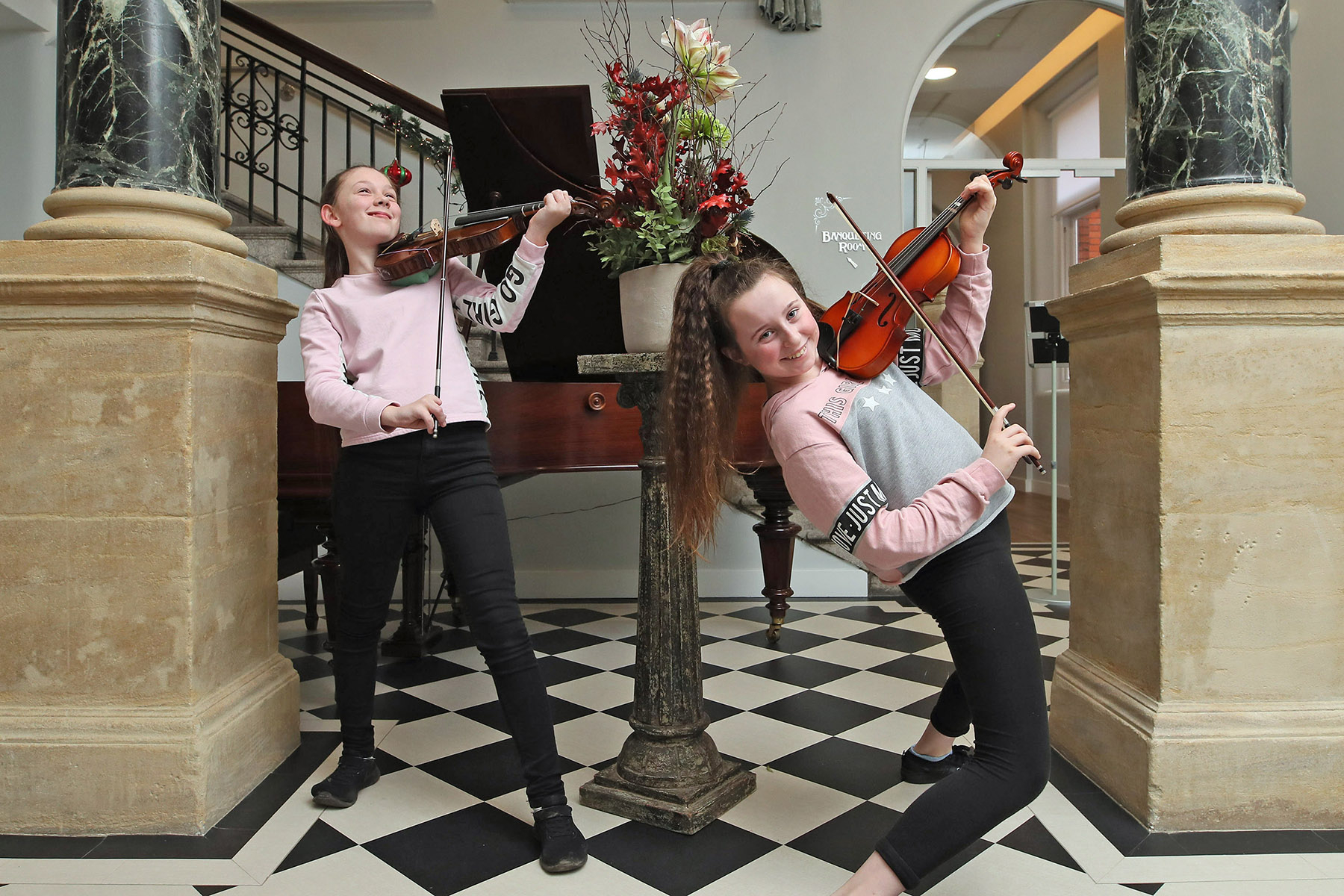Navigating IMM with The Human Safety Net
The Human Safety Net & Croce Rossa Italiana - Comitato di Milano | ESIR project
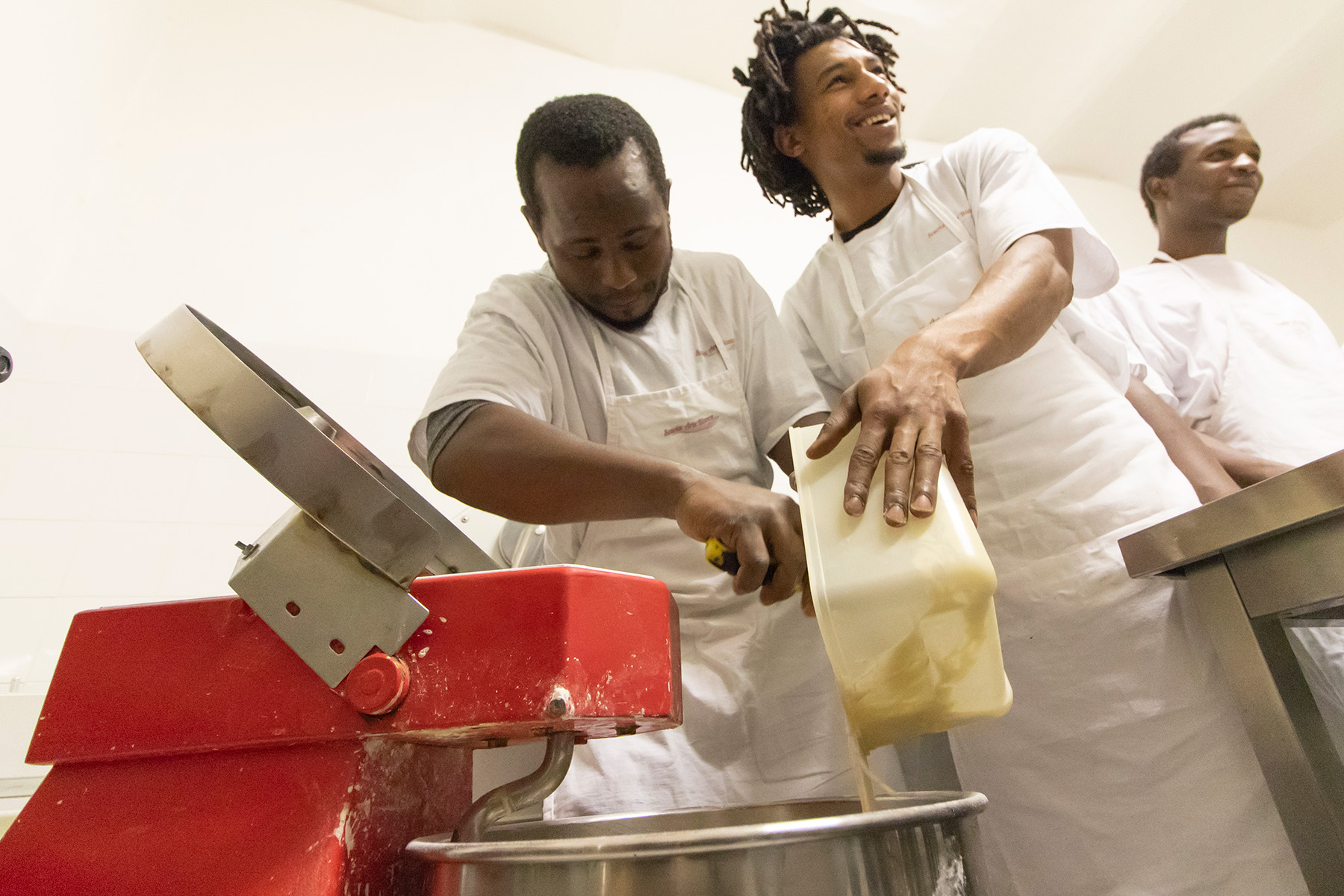
Investment strategy
The investor for impact
The Human Safety Net is a foundation set up in 2017 by the insurance company Generali Group, with the mission to “unlock the potential of people living in vulnerable circumstances so that they can transform the lives of their families and communities.”
The Human Safety Net supports, through a highly engaged grant-making approach, over 75 NGO partners in 26 countries across Europe, Latin America and Asia.
The activity of The Human Safety Net is split into two programmes: the For Families programme supports parenting during early childhood, while the For Refugees programme is focused on improving employment and fostering entrepreneurship of refugees.
The three levels of impact
The Human Safety Net looks at the three levels of impact, which EVPA defines as the investee level, investor level and ecosystem level.
The investee level refers to the impact that supported organisations have on beneficiaries. Through the For Refugees Programme The Human Safety Net supports partners that break down barriers to access the labour market, and/or support entrepreneurs to launch their own businesses.
The investor level is about the impact that the investor itself has on the supported organisations. The Human Safety Net has two major grant-making mechanisms, matching and scaling grants. From those that have an ambition to scale, the Scale-Up Impact grant is open to those partners who have demonstrated high impact programmes and are seeking multi-year funding focused on scaling and replication, as well as preparing the NGO partners for long-term financial sustainability (for example, through public sector adoption or by becoming social enterprises). This process comes alongside extensive non-financial support to enable the NGO partners to better measure and manage their impact, gain organisational resilience and strengthen their financial sustainability.
The Human Safety Net also aims to strengthen the ecosystem where it operates. For example, in 2022 it opened a purpose-driven space in Venice where social entrepreneurs can connect with peers, share best practices, host events and find a co-working area. Furthermore, The Human Safety Net invests in studies (such as a mapping of barriers to refugee entrepreneurship), and work with peer foundations to understand how to mobilise more funding in critical areas of need in the sectors where it operates.
The Theory of Change of the For Refugees Programme outlines how The Human Safety Net aims at achieving impact at the three levels:
IMM governance and resources
The Human Safety Net has a Monitoring, Evaluation and Learning & Capacity Development Manager, who is the person responsible for IMM as part of the programmes team.
The Board of Directors is actively involved in the operations of the foundation. The findings from the impact measurement and management process directly inform each decision taken.
The Social Problem
According to the United Nations High Commissioner for Refugees, in 2020 there were more than 26 million displaced people, holding a refugee status, around the world.
Access to the labour market is a crucial step for refugees building a future in their new country. However, they face barriers to finding long-term, stable and legal jobs.
In Milan, in 2021, only 10% of residents of refugee welcoming centres obtained a job contract of at least 1 year duration. Welcoming centres typically refer refugees to unemployment offices, which are in turn unable to provide them with tailored solutions.
The Italian Red Cross in Milan, Croce Rossa Italiana – Comitato di Milano, has a long-standing track record of supporting migrants and refugees in Lombardy. Although Croce Rossa has been historically more focused on serving humanitarian needs, their deep knowledge of the situation of refugees enabled them to spot the barriers to employability. Seeing an opportunity to help, they decided to start the project ESIR – Employability and Social Integration of Refugees. This project aimed to train refugees to increase their readiness for the labour market and enhance their prospects for finding meaningful jobs.
Aligning objectives
When the project was just an idea, Croce Rossa was not just looking for funding: they had acknowledged the social problem, and they had the trust and deep knowledge of the potential beneficiaries, but they were just assembling a new team to pilot the project and they were not sure this would become a permanent activity in Milan.
Croce Rossa had received initial seed funding for the ESIR Programme from the European Union, as part of a multi-country initiative to support emergent practices in enabling labor market access for refugees and vulnerable migrants. Once the pilot was successfully completed, Croce Rossa needed a partner that would bring expertise in refugee employability and technical assistance in private sector hiring. Without the support of The Human Safety Net, this project wouldn’t have made it beyond the pilot phase.
The Human Safety Net quickly saw that the ESIR program was well aligned with the objectives of the For Refugees Programme. However, as refugee employability was not at the time a core activity of Croce Rossa, The Human Safety Net’s team knew there would be a learning curve and co-creating journey to reach the ideal set up also in terms of connection between the research of candidates and the providers of training and work opportunities.
Due diligence and deal structuring
When The Human Safety Net and Croce Rossa started co-creating the next phase of the ESIR program, they worked to understand what business connections existed that The Human Safety Net could leverage on and how they could find additional employer partners. They also took an in-depth look at the types of sectors where refugees would be likely to find jobs and interviewed about 700 people to understand what skills and competences would be most needed for those jobs.
An important contribution from The Human Safety Net was the approach to impact measurement and management. Taking The Human Safety Net’s theory of change as a starting point to define the objectives, both organisations worked to define their aim of their collaboration and how they would track their progress.
At this stage, Croce Rossa believed their project had a high impact potential, but they had some difficulty to consistently demonstrate how individual lives were being transformed. They also wanted to understand the expectations of their beneficiaries.
For these reasons, Croce Rossa saw the value of having a thorough IMM approach. As they were constrained with time and bandwidth, they agreed with The Human Safety Net to have a flexible timeline. The Human Safety Net would not dictate which indicators to measure; instead they brought the tools and the IMM expertise to the table that would facilitate the co-creation process.
Setting indicators
Together, the partners decided to measure outputs such as how many participants would join the training and how many would be considered ready to be employed, and outcomes such as number of people that found a job thanks to the training, number of people employed after six months of the training, and number of participants that would find a permanent contract.
A key challenge at this stage was the lack of data to establish the baseline and thresholds or targets. Based on Croce Rossa’s knowledge on the profile of participants, they knew that they tend to be very young (between 18 and 25 years old); few had jobs and their readiness to access the labour market was low. A key element of the work of Croce Rossa in fact is that of orientation and preparation for the job market in terms of CV preparation, mock interviews, cultural specificity elements, etc. The partners knew that there was a limited awareness on how to find a job due to many recently arriving in Italy after fleeing their own countries.
Existing research provided insights to set targets. A study about migrants’ presence in the Milano Metropolitan Area helped the partners understand the percentage of migrants that get long-term jobs, and infer that the situation would be similar for refugees.
As the project was in the piloting phase and the baseline data was missing, The Human Safety Net and Croce Rossa included the output targets in the grant agreement, but left out the outcome targets – even though they planned to monitor and track outcomes.
Pilot grant (2019-2022)

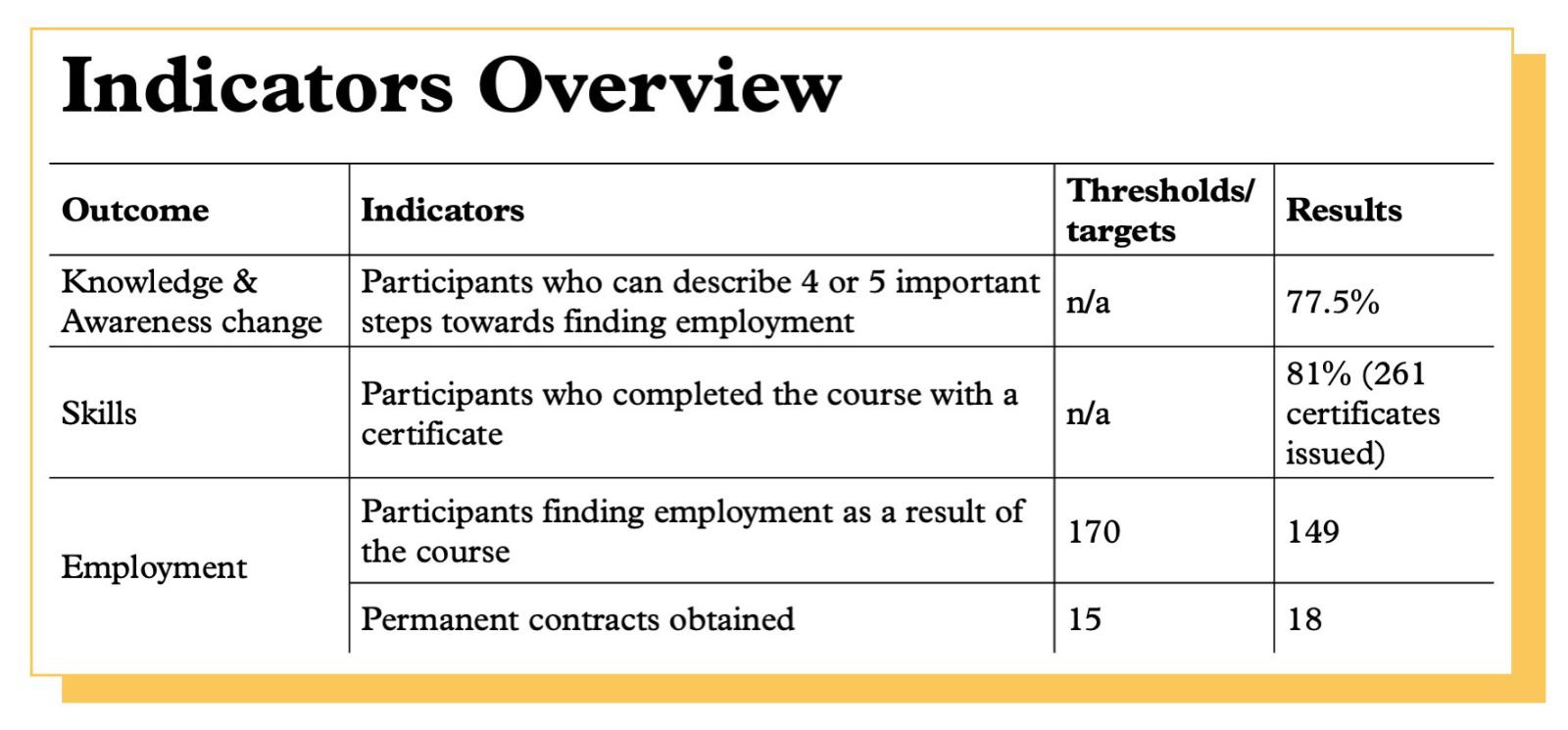
How were the results monitored?
During the 2019-2022 period, The Human Safety Net and Croce Rossa maintained a close relationship to monitor the results and strengthen the ESIR project. Croce Rossa shared the output results on a quarterly basis, and the outcome and impact indicators on an annual basis. These data led to an in-depth evaluation of the project which would inform the next stage, as well as enable the partners to better know the beneficiaries and their expectations. In addition, Croce Rossa published an annual report on their website, showcasing the impact of the project and guaranteeing its transparency.
Both partners kept having regular meetings through which The Human Safety Net provided technical assistance and capacity development. During these meetings, The Human Safety Net provided contacts and concrete partnership opportunities for the Croce Rossa team, as well as additional data analysis to inform the decision-making process and program design.
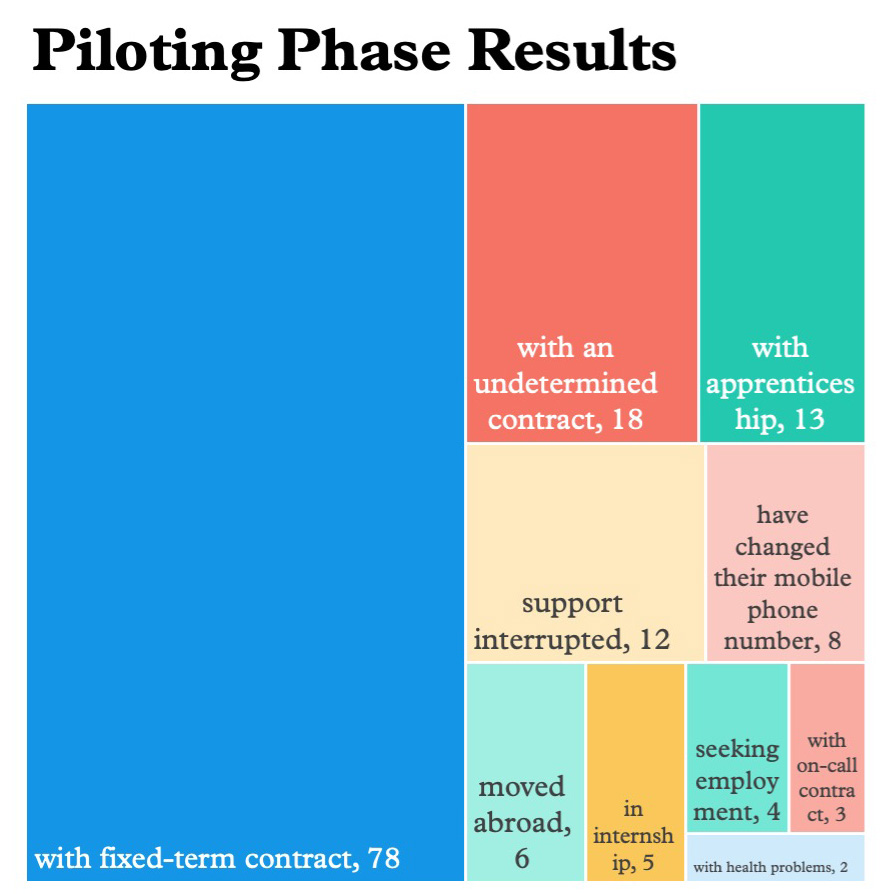
By the end of the program, out of 322 participants that had been selected to begin the employability training, 261 received the certificate of completion and 149 found a job at the close of the course. 119 of them were still employed six months after the course ended, and they will follow-up again at the one-year mark to track progress.
Impact learnings
The Human Safety Net supports projects that are rooted on the ground with deep knowledge of the people they want to support. Their strategy involves bringing technical assistance and IMM expertise to help the organisations understand and improve their impact from an early stage. Pilot grants, such as the one offered to the ESIR project, enable partners to gain major learnings that refine the solution for maximising impact.
Learnings enabled Croce Rossa to better understand the different profiles of beneficiaries, the employability prospects of each sector, trade-offs between outcomes and risks to be managed. Project partners learned more about the beneficiaries – their demographic makeup, for instance – from the real pool of applicants. Job-seekers who applied to the first program mainly came from Western African countries such as Senegal, Nigeria, Guinea, Ivory Coast and Mali. There may be a greater concentration of applicants in these countries based on where migrants are in their process to apply for asylum or official refugee status, which was a criterion to participate in the program. They represented a range of ages, and 90% of them were men (more on the imbalance between male and female applicants in a later section).
Impact verification
The most significant learning from the pilot phase was how to better incorporate participants’ perspectives. Croce Rossa knew the beneficiaries individually but had not yet aggregated their expectations to understand how they differed from initial assumptions. For example, the partners assumed that the more permanent contracts that resulted from taking this training, the better. However, thanks to their interviews with the first participants, they understood that while some sought a permanent contract, others were in urgent need of income and willing to accept short-term jobs. Sub-segmenting the beneficiaries according to their needs and expectations, and monitoring results based on their objectives, will be a crucial part of the next phase of the ESIR project.
Learnings from the first pilot also enabled understanding which sectors offer better prospects of employability and how to refine the trainings to prepare the participants to access those areas. Sectors such as construction, restaurants, warehouse and cleaning offer a relatively easy way to get an immediate job, but also entail lack of long-term stability, independently of the employer’s satisfaction of the employee work quality.
A desk review by The Human Safety Net programmes team identified that across Italy there is a gap in filling jobs in the IT and communications service sector with 49.2% of jobs on offer remaining unfilled, particularly in the northern part of Italy. Unlike seasonal jobs that often have 3-6 month contracts, there is a greater chance that IT jobs could be structured on a longer-term basis, and often there is not as high of an Italian language skill level required for other sectors that offer more long-term and permanent contracts . Furthermore, it was identified that The Human Safety Net can leverage its network for this sector in particular to support employer partnerships. Because IT (web development) jobs proved to be a good fit for the participants, the partners established a target of 25% of the next cohort finding a job in the IT sector. If The Human Safety Net and Croce Rossa see that this is successful, they might pilot a training fully focused on IT, but first they need to further assess the participants’ expectations.
Risk management
The first pilot enabled the two partners to better understand the risk of achieving unintended consequences and establish mitigation measures. One risk is directing participants to a sector that is not a proper fit for their interests or expectations. For this reason, even if a target of 25% of jobs focused on IT has been identified, there is no particular threshold to be met, before having a clear sub-segmentation of beneficiaries and the subsequent tailoring of the trainings. For The Human Safety Net, innovation entails seeing the value in learning and piloting before scaling.
Another reality of the program was the low presence of female participants. Aggregated at The Human Safety Net level, refugee employment programs have 67% of male participants, but for the ESIR project the concentration was 90%. This is mainly due of course to the strong connection between Croce Rossa and refugee welcoming centres, which have a high concentration of men, which in turn represents the composition of refugee applicants into the country. The Human Safety Net wants to make sure it including the gender equity lens and thus plans to incorporate monitoring of gender at all phases of recruitment and consider additional projects that may serve more women refugees, where applicable.
Reporting impact
The Human Safety Net publishes an annual activity report on their website . Having a sector-specific approach allows The Human Safety Net to aggregate results of each program, as well as outline its impact at the investor and ecosystem level. This report is distributed across the supported organisations. Furthermore, The Human Safety Net has a dashboard, shared with partners, where they can disaggregate the data and see types of activities run, beneficiaries reached and outcomes achieved.
Follow-up grant (2022-2024)
Deal overview
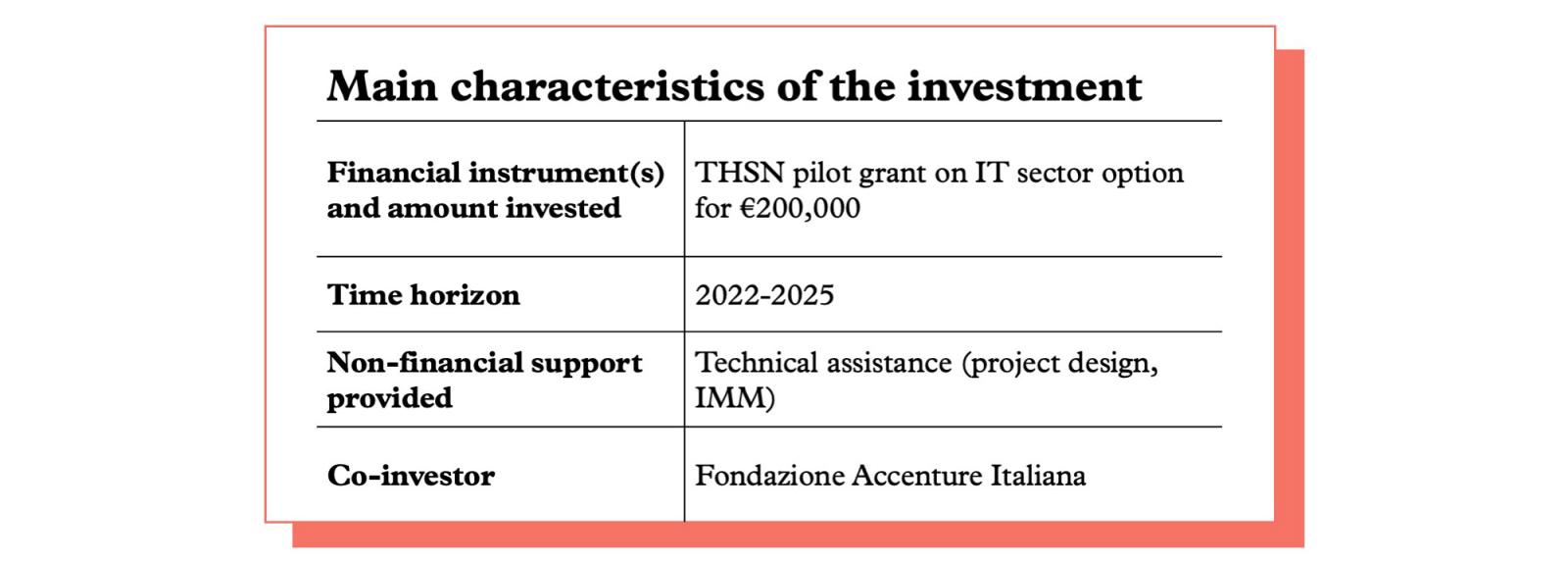
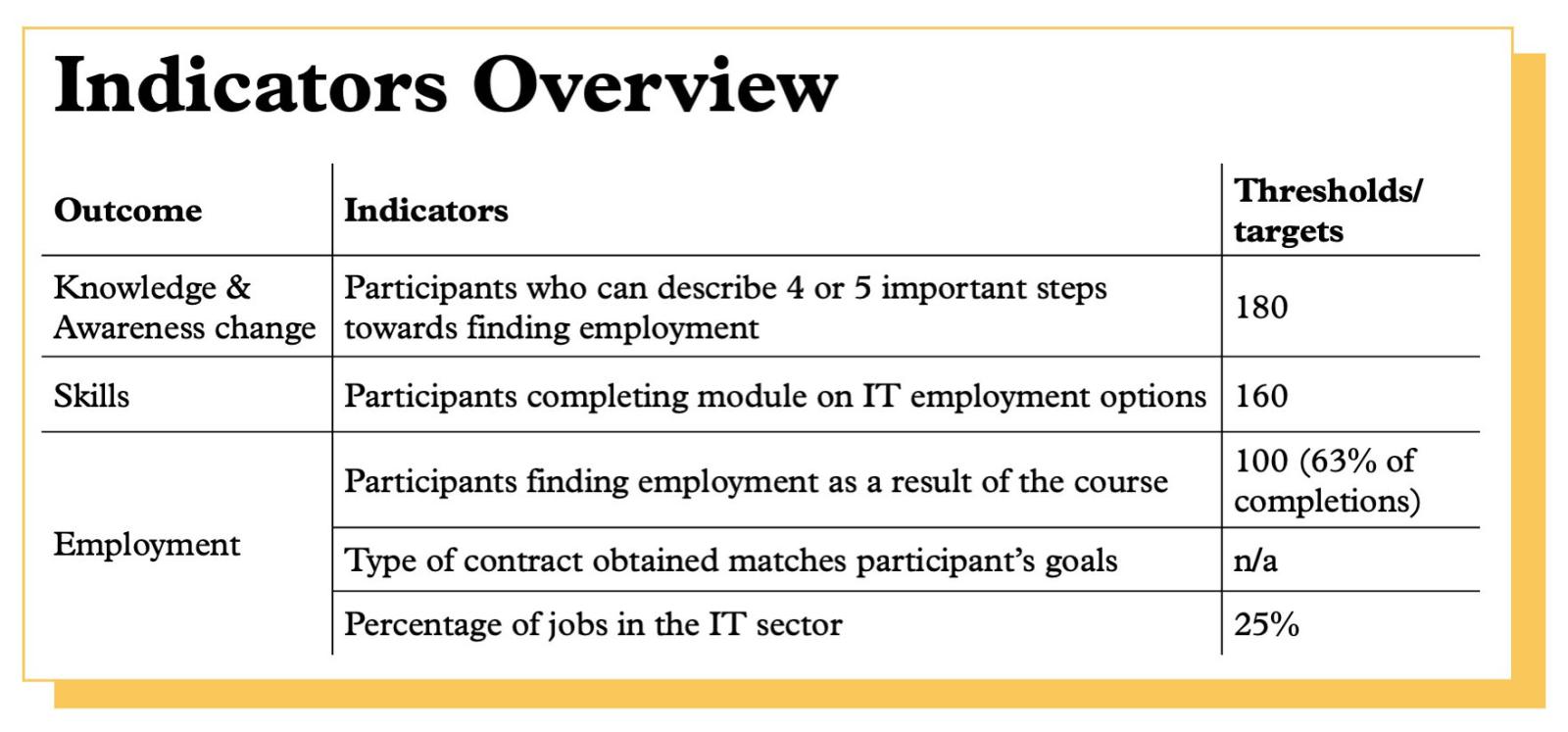
Based on the learnings from the pilot ESIR project, The Human Safety Net and Croce Rossa will continue their partnership, incorporating new refinements and further tailoring their support to the needs and expectations of each participant. They aim to train 180 people during the follow-up period (2022-25), with the ambition that 25% of participants find a job in the IT sector and 38% in other sectors of work, based on interest. Overall the project aims for 60% to find employment at the end of the course, whereas the remaining may continue training with the Red Cross or other options.
To increase the project’s chances of achieving these goals, the partners have secured co-financing from Fondazione Italiana Accenture (Accenture Foundation in Italy), an instrumental party to unlock more employment opportunities in the IT sector. Croce Rossa will continue collaborating with other employer partners that offer job opportunities more tailored to participants seeking short-term solutions.
Finally, as the human resources of the ESIR project have grown, project partners will strengthen their IMM practices by assessing other outcomes such as soft skills and self-confidence of the beneficiaries.
What next?
If the 2023-2025 period goes as expected, Croce Rossa may be interested in replication or another approach to scale their impact. The Human Safety Net may foresee a Scale-Up Impact grant, which lasts for three years, and intends to facilitate the long-term financial sustainability of the project. In this case, a possible endgame would be the integration of the ESIR project with the welcoming centres, which are owned by the public sector.
Check out the impact story


